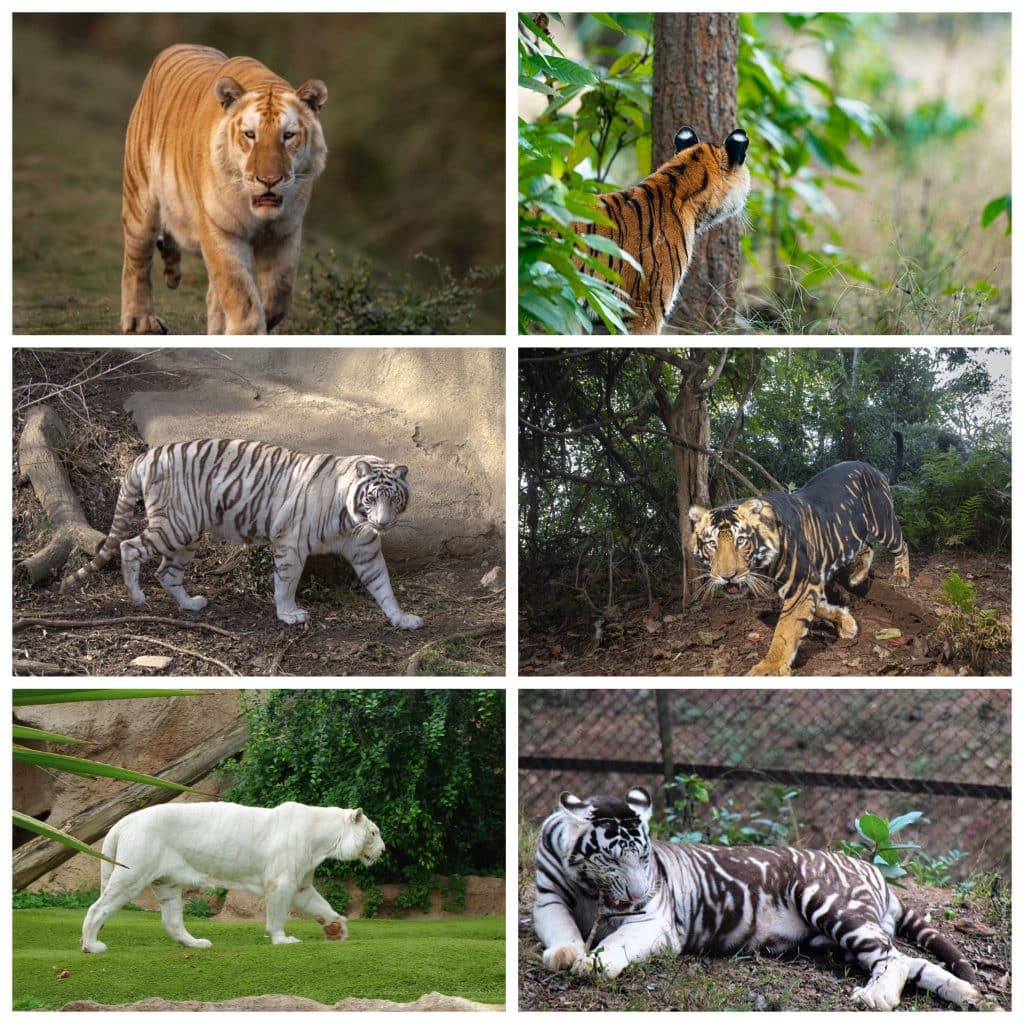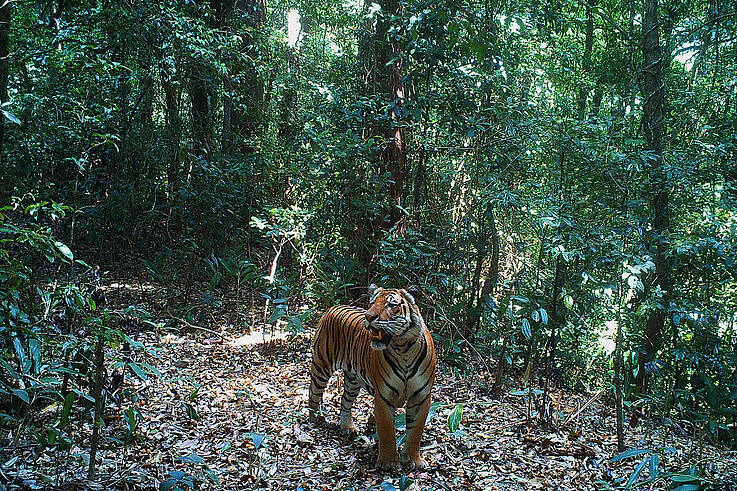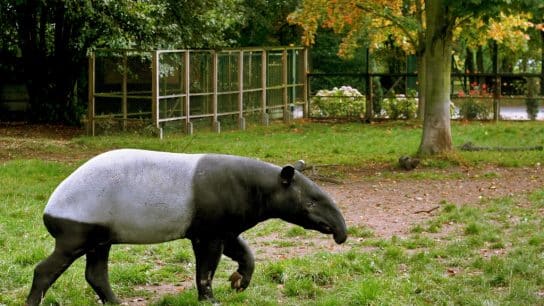Among the most admired species in the animal kingdom is the majestic tiger, the largest wild cat in the world. Easily recognised by its uniquely striped, reddish-orange coat, the tiger is an apex predator across its endemic range states and holds cultural significance at national and local levels. Despite this widespread reverence, tiger populations have been declining for decades primarily due to anthropogenic threats, such as poaching, habitat loss, and the depletion of prey stocks. While conservation efforts for flagship species are typically well funded and tend to garner widespread public attention, the implementation of multifaceted, evidence-based conservation measures that adequately reflect the needs of both the target species and of local communities is a complex, lengthy process.
—
| Family | Felidae |
| Genus | Panthera |
| Species | Panthera tigris |
| Subspecies | P. t. altaica (Amur tiger); P. t. corbetti (Northern Indochinese tiger); P. t. jacksoni (Malayan tiger); P. t. sumatrae (Sumatran tiger); P. t. tigris (Bengal tiger); and P. t. amoyensis (South China tiger). |
| IUCN Status | Endangered |
| Population | 2,608 – 3,905 mature individuals (best estimate: 3,140) |
1. Taxonomy
The evolutionary history and genetic diversity of tigers is a topic that still remains relatively understudied. Since 2004, the intraspecific taxonomy of Panthera tigris has been the subject of debate due to conflicting results from different methodologies.
Luo et al. (2004) utilised the analysis of mitochondrial DNA to identify six subspecies, whilst Wilting et al. (2015) identified just two subspecies based on morphological (craniodental and pelage), ecological and molecular traits. However, these inconsistencies were partly attributed to an insufficiency of genetic samples across the range of the species. Liu et al. (2018) subsequently employed whole-genome sequencing analyses on 32 voucher specimens, which resolved six statistically robust monophyletic clades corresponding to extant subspecies with little admixture and gene flow between them. Nevertheless, due to the varied data results, the taxonomy of Panthera tigris remained under review by the International Union for Conservation of Nature’s Species Survival Commission (IUCN SSC) Cat Specialist Group.
The six extant subspecies identified by Liu and his team in 2018 were: the Amur tiger (P. t. altaica); the Northern Indochinese tiger (P. t. corbetti); the Malayan tiger (P. t. jacksoni); the Sumatran tiger (P. t. sumatrae); the Bengal tiger (P. t. tigris); and the South China tiger (P. t. amoyensis), although this subspecies is considered to be extinct in the wild. Three extinct subspecies were also recognised based on morphological traits: the Bali tiger (P. t. balica); Javan tiger (P. t. sondaica); and the Caspian tiger (P. t. virgata).
The two subspecies identified by Wilting and his team in 2015 were: Continental tigers (Panthera tigris tigris), under which virgata, altaica, amoyensis, corbetti and jacksoni were subsumed, and Sunda Island tigers (Panthera tigris sondaica), which included balica and sumatrae.
Most recently, Armstrong et al. (2021) re-sequenced 65 individual tiger genomes derived from the most extant subspecies, with a focus on tigers within India (where 70% of the world’s wild tigers are found). The study revealed genome-wide signatures of phylogeographic partitioning and evidence for long-term restriction of gene flow and adaptive divergence. These results therefore reinforced earlier analyses suggesting significant genetic differentiation between six putative tiger subspecies, despite a relatively recent divergence of 20,000 years between tiger populations. Authors noted that such swift genetic differentiation highlights the role of genetic drift or stochastic processes, as well as intense population bottlenecks, in recent tiger evolution.
Intraspecific taxonomy and a comprehensive understanding of a species’ natural history from a genomic perspective is of critical importance to conservation planning, as it provides the foundation for the implementation of data-driven, evidence-based measures. By recognising the genetic diversity, evolutionary uniqueness, and potential of different tiger populations, conservation strategies can better reflect the specific biological and ecological needs of each subspecies, particularly the rarest and most endangered populations.
You might also like: 10 of the World’s Most Endangered Animals
2. Appearance
The majestic tiger has a striking, reddish-orange coat with pronounced black stripes, white fur on its ventral side, and a single white spot behind each ear. A tigress will use these white spots to communicate with her offspring by flattening her ears upon sensing danger, prompting her cubs to hide. The black stripe pattern of a tiger is unique to each individual, similarly to human fingerprints, allowing researchers to identify different specimens in the wild.
Due to genetic factors, some variation in pelage colouration does occur in tigers, particularly within India. In 2007, ‘black’ or ‘pseudo-melanistic’ tigers were officially discovered in Similipal Tiger Reserve, Odisha; the only wild population to currently exhibit this trait. Due to an extremely rare genetic mutation, these tigers have thicker, darker stripes that merge together, thus appearing to be almost black in colour. Despite the rarity of this mutation, approximately 37% of tigers in the Similipal Tiger Reserve are pseudo-melanistic. In a 2021 study on the ongoing phenotypic evolution of pseudo-melanism in tigers, Sagar et. al. (2021) highlighted the possibility of inbreeding and population bottlenecks within the small, isolated population of Similipal.
White tigers were first observed among wild Bengal tiger populations in India, and exhibit white fur and sepia brown stripes due to an autosomal recessive trait. Golden tigers have pale-golden fur and reddish-brown stripes, also due to an autosomal recessive trait. The rarest variant, caused by a polygenic trait determined by dual-recessive effects, is the snow white tiger, which is almost completely white with faint or near non-existent stripes on its body and light sepia brown rings on its tail.

When hunting, tigers typically deliver a rapid but fatal bite to the throat of their prey. These fierce predators therefore have razor-sharp canines that can reach up to 10 centimetres in length, strong jaws with a bite force of 1,050 psi (whereas a human has a bite force of around 160 psi), and incredibly agile bodies.
The Amur tiger is the largest subspecies of tiger, as well as the largest wild cat, with males measuring up to three metres and weighing up to 300 kilograms. The Sumatran tiger is the smallest subspecies, reaching a maximum weight of 140 kilograms and measuring 2.4 metres. All subspecies appear to display slight sexual dimorphism, with females tending to be smaller than males.
3. Diet
Tigers are solitary, ambush predators, hunting prey with an incredible display of stealth, speed, agility and strength. Camouflaged by its striped coat, a tiger will lie in wait or actively search for prey and pounce once the opportune moment arises, aiming for the animal’s neck. Since the species primarily hunts at night, prey is identified through sight and sound. To enhance their nocturnal vision, tigers have an additional layer of reflective tissue in the back of their eyes called the tapetum lucidum. Located behind the retina, this layer of tissue reflects light that enters the pupil so that it hits the light-detecting cells of the eye twice, improving the vision of the tiger.
Tigers are also skilled swimmers and have been observed hunting in water.
As apex predators and obligate carnivores, tigers primarily consume large ungulates such as wild pigs and deer of various species. These powerful cats are capable of taking down ungulate prey much larger than themselves, such as water buffalo, gaur, banteng, and even Asian elephants and rhinoceros. Yet, similarly to most large carnivores that display optimal feeding behaviours, tigers will prefer prey of a similar weight to themselves. A tiger is typically successful in taking down large prey once a week, killing approximately 50 to 60 large animals per year. Although some subspecies can consume up to 34 kilograms of food in one night, most will consume approximately 5 kilograms in one meal, covering the carcass and returning to feed in the following days. If preferred prey stocks are depleted, tigers will opportunistically hunt sub-optimal prey, such as birds, fish, rodents, amphibians, reptiles, primates and porcupines. If found in close proximity to human settlements, tigers may also consume domestic animals, such as cattle and goats.
4. Habitat & Behaviour
Once inhabiting a wide range of countries across Asia, from Turkey to Russia and on the Indonesian islands of Java and Bali, tigers currently occupy less than 6% of their 1900 AD range. Having been driven to extinction in Singapore (1930s), Bali (1940s), Java and Hong Kong (1960s), central Asia (1970s), the majority of mainland temperate and tropical China (1980s-1990s), and most recently in Vietnam, Lao PDR and Cambodia (2000s), breeding subpopulations are now found in a mere 11 countries. These are: Bangladesh, Bhutan, China, India, Indonesia, Malaysia, Myanmar, Nepal, Russia, and Thailand. Although the species has also been confirmed in Myanmar, southern and eastern subpopulations are believed to depend on immigration from Thailand.
Despite this recent, drastic range collapse, tigers are habitat generalists and thus occupy diverse environments, such as: estuarine mangrove forests and equatorial rainforests in the Sundarbans and Sumatra; dry deciduous forests within parts of India; tropical rainforests in the Malay Peninsula; and the temperate, evergreen forests of Palaearctic realms in Russia and China. The principal habitat requirement for tigers, and the factor that determines the size of an individual tiger’s territory, is the availability of sufficient prey stocks. Solitary by nature and aggressively territorial, tigers will mark their domain with scent markings (urine and faeces), scratchings on trees, as well as vocalisations. Female tigers typically give birth to litters of three or four cubs and care for them until they are able to hunt, usually by the age of 18 to 24 months.
Despite the incredibly wide variety of habitats that tiger populations inhabit across Asia, genome sequencing for the identification of signatures of selection and local adaptation among subspecies is still in its infancy. Liu et al (2018) identified possible signatures of adaptive evolution in Sumatran tigers, such as darker pelage (potentially to provide greater camouflage), a smaller body size (potentially to reduce calorific demand and enable the exploitation of smaller prey), and metabolic adaptations to tropical climates. Armstrong et al. (2021) further noted that genomes sequenced from Amur tigers revealed signals of selection on lipid metabolism genes and pathways, associated with possible adaptations to cold climates. Signatures of selection on these lipid metabolism genes have also been identified in two human populations (Greenlandic Inuit and Indigenous Siberians), as well as in polar bears. Finally, given historical records of Bengal tiger occupancy across a significant range of habitats, the subspecies displayed the greatest amount of genetic variation in genome-wide diversity estimates.
You might also like: Siberian Tigers: Facts, Threats, and Conservation Efforts
5. Ecological Importance
An apex predator, the tiger plays an incredibly important role in shaping and maintaining the vitality of the ecosystems it inhabits. By consuming herbivorous ungulates, tigers prevent overgrazing and maintain ecological integrity by controlling the density of grazing species. Due to their solitary nature and expansive home ranges, tigers are considered to be an ‘umbrella’ species, as the the conservation of their native habitats confers protection to a large range of naturally co-occuring species. The tiger has also been referred to as a ‘keystone’ species, as the density and health of specific tiger populations is highly indicative of the vitality and integrity of the ecosystem they reside in. The conservation of tiger landscapes further protects at least nine major watersheds, which regulate and provide freshwater for more than 800 million people across Asia. If driven to extinction, the loss of tiger populations across Asia would result in significant disruptions to the integrity, vitality and natural order of countless ecosystems, as well as to the communities that depend on these natural resources for their survival.
6. Threats
Although the IUCN regards global tiger population estimates as relatively uncertain, the organisation has taken a precautionary approach in designating the species as ‘Endangered’ given their extirpation from several countries since the turn of the century, as well as the fact that numerous populations continue to face severe anthropogenic threats. In some regions, conservation measures have been sufficiently successful to produce stability or even increases in national tiger numbers, such as in India, Nepal, Thailand and Northeast Asia. Nevertheless, Southeast Asia continues to see declines in tiger counts. Although gains in Northeast and South Asia, where tiger densities are higher, may result in an overall increase in global tiger population estimates, the aforementioned genetic diversity and uniqueness of all six subspecies, particularly those under greater threat of extinction, deserve to be safeguarded. The primary threats to tigers are anthropogenic in nature: poaching; habitat loss and fragmentation; prey depletion; and infectious disease.
The tiger has long been a primary target for the illegal wildlife trade, with poachers selling every part of the animal, from whisker to tail, across both local and international markets. Although the species has been protected under Appendix I of the Convention on International Trade in Endangered Species of Wild Fauna and Flora (CITES) since 1975, as well as under national legislation in numerous range states, the high financial value placed on products such as skins, teeth, bones, meat and organs, coupled with consistent demand for such products, have ensured that the practice continues.

The use of tiger body parts is deep-rooted in certain cultural and medicinal practices within Asia, particularly in China and Vietnam. Tiger bones, used to make wine and tonics in traditional Chinese medicine, are believed to possess numerous healing properties, such as strengthening muscles and relieving pain and inflammation. Tiger skins, canines, claws, and other body parts are typically purchased as symbols of social status and wealth, in the form of ornaments, carpets, coats, or taxidermy trophies, and can fetch up to 70,000 USD.
Between January 2000 and June 2022, approximately 3,377 tigers were confiscated from traffickers across 50 countries: 1,319 whole tigers; 11,528 bones; 1.1 tonnes of meat; 2,737 claws; 1,217 whole skins; 426 skulls; 933 teeth; 469 whiskers; 106 paws; 610 skin pieces; and 13 tails. Nevertheless, these figures are unlikely to reflect the true extent of the trade. Resources for the enforcement of legislation, the conservation of prime tiger habitat, and the apprehension of poachers are often limited in countries where tigers are found, particularly given the lucrative nature of the market. Trade routes in non-government controlled areas, such as the northern region of Myanmar bordering China, are also heavily exploited due to the lack of restrictions or regulations imposed in the area.
Exacerbating the situation is the fact that there are approximately 8,900 captive tigers held across 300 farms and facilities in Asia, predominantly located in China, Lao PDR, Thailand and Vietnam. These establishments, which range from residential basements to licensed battery-cage farms, typically smuggle tiger cubs from the wild and implement captive breeding programs to meet increasing demands from the illegal wildlife market. Although the practice of farming endangered species purports to lessen poaching pressures for wild populations, it has rather been found to further perpetuate the demand for tiger parts by appearing to legitimise and normalise the trade. Captive tigers are kept in appalling conditions, confined to small cages, malnourished, and deprived of the ability to exhibit natural behaviours. Studies have also revealed that consumers of tiger products, such as tiger bone glue in Vietnam, actually prefer to purchase products that emanate from wild tigers, and that these consumers would continue to purchase illegal, wild-caught products regardless of whether legal tiger farming were to exist in more countries.
At present, commercial tiger farms are only legal within China, where the practice was introduced in the 1980s. In 2018, the Chinese government reversed a 25-year ban on the use of tiger bone in traditional Chinese medicine, allowing the use of captive-bred tiger bones in certain circumstances. Despite undergoing a revision in 2020, China’s current Wildlife Protection Law continues to allow the use of captive-bred tiger parts by companies that are authorised to produce and sell tiger bone wine and tiger skins. In 2018, the government of Lao PDR ordered the closure of all tiger farms within the country, however legislative loopholes and weak enforcement have allowed facilities to avoid detection or masquerade as zoos, thus continuing to exploit the species.
As aforementioned, wild tigers currently occupy less than 6% of their 1900 AD range. Due to the continuous growth of human populations across Asia, land is increasingly cleared or disturbed for infrastructural development, the exploitation of natural materials, as well as the establishment of agricultural farms, settlements, and plantations. Between 2001 and 2019, approximately 610,000 square kilometres of forest was lost in Southeast Asia, primarily for the cultivation and production of rice, palm oil and rubber. Limited resources and opportunities for revenue across local communities further result in their reliance on surrounding ecosystems for their survival. In addition to hunting tigers, which provides a considerable income to poachers, main prey sources such as deer and boar are caught at high volumes for local consumption. With depleted prey stocks and an extremely limited range of habitat, tigers are often seen entering human settlements to catch livestock or domesticated animals, exposing them to the threat of retaliation or poaching.

The fragmentation of breeding populations by large-scale infrastructural or urban development projects also exposes tigers to the risk of inbreeding and atypical phenotypic variation, reducing the fitness and vitality of future generations.
When comparing the genomes of both Amur tigers and Bengal tigers, researchers discovered that Amur tiger populations harboured fewer long runs of homozygosity (ROH) than their Bengal counterparts. Runs of homozygosity arise when offspring inherit identical haplogypes from each parent, indicating potential inbreeding and recessive inheritance due to isolation. While India’s landscape is characterised by variable habitats and extremely high human population densities, the Russian Far East instead hosts more continuous habitats with low human population densities. Inevitably, individual movement within Bengal tiger populations is incredibly hindered, as urban barriers force breeding populations into small, isolated pockets of fragmented land. Left with limited options, individuals in these small populations are more likely to mate with relatives. Amur tigers, on the other hand, face no significant barriers to individual movement. Despite lower population densities, Amur tigers have been shown to be more panmictic, with little or no indications of geographic population substructure. Without habitat connectivity, tiger populations may become locally or functionally extinct in regions where urbanisation and deforestation occur at rapid rates.
Lastly, infectious disease has been described as a potential threat to wild tiger populations. Although the topic remains understudied and thus poorly understood, instances of tiger deaths attributed to canine distemper virus (CDV) have been reported in Russia and India. The virus is particularly threatening to small, isolated tiger populations with limited habitat continuity. In 2004 and 2010, CDV was coincident with a localised decline of tigers in Sikhote-Alin Zapovednik, Russia, with a loss of 16 tigers over the span of four years. Disease further affects main prey stocks for tigers, such as the spread of African Swine Fever in Russia and Indonesia.
You might also like: Why Is the Amur Leopard Endangered?
7. Conservation
As aforementioned, conservation efforts for flagship species, such as the tiger, are typically well funded and garner widespread public attention. However, due to the complexity of threats facing tiger populations across Asia, there is an urgent need for further evidence-based, multifaceted conservation initiatives that are able to reflect the needs of both tiger populations and the local communities that they cohabit with. Given that remaining wild tigers are located in one of the most densely populated regions in the world, coupled with their need for expansive home ranges and their susceptibility to human conflict, conservation strategies should focus on strengthening political will and legislative enforcement to reduce poaching, prohibit the degradation of prime tiger habitat, and to put an end to the illegal wildlife trade, including the closure of tiger farms across Asia. By banning the grant of logging, agriculture, palm oil, and other concessions that typically result in deforestation, and thus expose tigers to inbreeding depression, poaching and increased contact with human settlements, governments and conservationists can work together with local communities in developing strategies to protect tiger habitats, create safe corridors for movement, minimise conflict, and implement sustainable tourism or agricultural practices that benefit both tiger and human populations.
In 2008, the World Bank established the Global Tiger Initiative, a group comprised of all tiger range countries and tiger conservation stakeholders, which was tasked with developing a collaborative strategy for safeguarding wild tigers from extinction. At the 2010 Tiger Summit, the Global Tiger Recovery Program (GTRP) was launched with the primary goal of doubling the number of wild tigers by the year 2022. This was to be achieved through the implementation of the following actions: the effective preservation, management, enhancement and protection of tiger habitats; the eradication of poaching, smuggling and the illegal trade of tigers, their parts and derivatives; increased cooperation in transboundary landscape management and in combating illegal trade; increased engagement with indigenous and local communities; increased effectiveness of tiger and habitat management; and the restoration tigers to their former range. The performance of each tiger range country in implementing the goals of the GTRP was assessed and scored in order to maintain accountability, and to serve as a mechanism for feedback and improvement.
In 2022, data released by the IUCN revealed that, while global tiger population counts had risen, the progress was uneven. Bangladesh, Bhutan, India, Nepal, China and Russia had made significant progress towards increasing and protecting regional tiger populations, primarily though habitat protection, strong political will, anti-poaching measures, prey-augmentation, and improved resource allocation. However, in Southeast Asia, tigers continued to face serious threats of poaching, habitat loss and fragmentation, largely due to a lack of investment and inadequate resources. Therefore, at the Fourth Asia Ministerial Meeting on Tiger Conservation in 2022, the South East Asian tiger range countries decided to collectively prioritise common actions through a South East Asia Tiger Recovery Action Plan (STRAP), which accompanied the second Global Tiger Recovery Program.
The GTRP 2.0, launched in 2023 and is scheduled for review in 2034, contains a set of 56 KPIs to measure progress towards the goal of increasing and safeguarding global tiger population counts. In alignment with the Post-2020 Global Biodiversity Framework, the GTRP 2.0 set out the following overarching outcomes, among others: increased political and financial investment by tiger range country governments, support from funding agencies and the private sector; high-level protection for tiger and prey populations at country and transboundary levels; the implementation of data-driven planning, monitoring, and habitat management for tigers, prey and habitats; effective management of human-wildlife conflict with stakeholder engagement; the promotion of policies for natural resource stewardship and conservation incentives; and significant reductions in legal trade in tigers and their parts in source countries, as well as reduced remand for tiger derivatives in consumer countries.
Perhaps the most critical conservation action for safeguarding tiger populations is the protection of suitable habitats, which includes maintaining habitat connectivity and augmenting prey stocks. According to the IUCN, governments of tiger range countries must identify and secure ‘source sites’ – protected areas with the confirmed presence of breeding tigers, including population estimates of over 25 breeding females, that are embedded within a larger habitat landscape with the potential to hold over 50 breeding females – as well as habitats beyond protected area boundaries that historically or currently have the potential to support breeding populations or act as corridors.
At present, many source sites are too threatened or degraded to support species recovery, and only 21% of suitable tiger habitats are legally protected, with a mere 9% of these habitats defined as “strictly protected” by the IUCN. Some tiger conservation landscapes remain as designated concessions for resource extraction, such as timber, oil, and plantations, and many protected areas suffer from poor regulatory, budgetary and enforcement effectiveness. Although data on tiger occurrence is becoming increasingly accurate across tiger range countries, there remain data gaps in remote areas of South East Asia, as well as the Himalaya of India, Nepal and Bhutan, that could hold significant recovery potential or accommodate range shifts as a result of climate change.
By allocating greater resources to the identification and strict protection of tiger landscapes, including the implementation of anti-poaching measures, bans on resource extraction projects, and the expansion of protected area boundaries to include habitat corridors, wild tiger populations may begin to recover naturally with increased gene flow between them. Targeted tiger reintroductions and translocations to protected areas within the species’ historical range have already begun in India and Russia, and are planned to occur in Kazakhstan and Cambodia.

Nevertheless, converting areas of habitat into protected tiger conservation landscapes requires not only governmental initiative, but also engagement from local communities and indigenous groups that cohabit with tigers.
In April 2023, as India’s Prime Minister Narendra Modi announced promising increases in national tiger population counts since the launch of Project Tiger in 1973, India’s conservation model for creating protected tiger reserves, indigenous groups protested that such conservation strategies had uprooted communities that had resided in the forests for millennia. A number of Indigenous groups joined together and established the Nagarahole Adivasi Forest Rights Establishment Committee to protest against fortress conservation, under which local communities are evicted from forest regions for the protection of endangered species. Rather than simply evicting indigenous groups, it has been suggested that forests could be collaboratively managed by local communities and government officials, allowing locals to utilise forest resources in a sustainable manner whilst safeguarding the ecosystems within it. This model of community-managed forest conservation has been successful elsewhere, such as in Nepal where locals act as Forest Guardians to safeguard red panda populations.
Since indigenous groups, many of which hold a cultural or spiritual respect for the environment, derive greater benefit from clean, undisturbed habitats, conservation strategies should focus on banning the grant of concessions on protected land, introducing sustainable opportunities for income, such as eco-tourism or sustainable agriculture, and the implementation of education initiatives in local schools to foster a genuine interest for environmental conservation. Strategies for minimising conflict between human settlements and tigers, such as increasing prey stocks in forests bordering villages, creating suitable habitat corridors, or implementing compensation schemes for farmers that lose livestock, should also be prioritised for the safety of both humans and tigers.
NGO Spotlight: David Shepherd Wildlife Foundation
Founded in 1984 by David Shepherd CBE, the David Shepherd Wildlife Foundation (DSWF) is a conservation charity operating across Africa and Asia to eradicate wildlife crime and protect endangered species in their natural habitat. By funding and supporting long-term frontline conservation projects in India, Thailand and Russia, funding investigations into the wildlife trade, participating in international policy conventions, lobbying at governmental level, and strengthening law enforcement, habitat protection, and community engagement programmes, DSWF have contributed significantly to safeguarding wild tiger populations and to the ongoing eradication of the illegal wildlife trade.

In 2023, DSWF raised almost £23,000 in their appeal, ‘The Dark Side of the Illegal Tiger Trade’, which highlighted the number of tiger lives lost each year to meet the demand for the illegal wildlife market. Having been provided with long-term support, partners of DSWF have successfully investigated wildlife trafficking routes in Malaysia, Thailand, Myanmar, China, Laos and Vietnam, with the following outcomes: 33 intelligence reports detailing the trade were produced; 28 individuals involved in the trade were identified; one criminal network was mapped; and five tiger facilities of concern were identified. The information from intelligence reports has enabled law enforcement officials in tiger range countries to obstruct the trade of tigers and apprehend those involved. These reports are also utilised by the Financial Action Task Force, an inter-governmental organisation that deals with money laundering and terrorism financing, to determine the role of criminal organisations in tiger farming and highlight the weaknesses in national wildlife legislation, such as in Laos. If, in light of reports of legislative inefficiency, Laos fails to improve laws on tiger farming and trade, the country may face global financial sanctions.
In India, DSWF supported the training of four K9 Units, which now assist in tracking and apprehending poachers. Their presence in tiger conservation landscapes further acts as a deterrent to potential poachers. A field partner of DSWF, the ‘Rhino and Tiger Goes to School’ programme, has implemented a number of education initiatives to generate awareness about tigers within schools and encourage an interest in conservation. Approximately 3,680 students have participated in the programme so far, all of which reside in villages bordering rhino and tiger habitats. By educating young children about the habitat, behaviour, population, distribution and conservation challenges of endangered species, such as rhino and tigers, the programme is designed to foster genuine care for wildlife from a young age, creating a new generation of conservationists and wildlife protectors.
In Thailand, DSWF has been involved in supporting part protection and law enforcement monitoring work, as well as enhanced ranger training for safeguarding endangered wildlife, such as tigers and pangolins. Thus far, rangers have patrolled around 34,723 kilometres in the past six months, which resulted in the apprehension of 68 poachers and the confiscation of 21 weapons.
How Can You Help
- Donate to Tiger Conservation. Organisations such as the David Shepherd Wildlife Foundation raise funds to support and finance frontline conservation initiatives across Asia. By donating to their appeals, you can contribute to anti-poaching, habitat conservation, and community engagement efforts, as well as supporting the end of the illegal wildlife trade.
- Steer Clear of Tiger Products. Poaching and the illegal wildlife trade are one of the primary causes for the decline in wild tiger populations. If you know anyone that purchases medicinal products, ornaments or other products that contain tiger parts, make sure to let them know of the immense threat that the trade poses to the future of the species.
- Don’t Support Zoos or Tiger Farms. When travelling across South East Asia, stay away from facilities claiming to be zoos or those that are clearly tiger breeding farms. These animals are kept in appalling conditions and are likely bred for the illegal wildlife trade.
If you enjoyed this article about the endangered Tigers, you might also like: Red Pandas: Endangered Animals Spotlight















